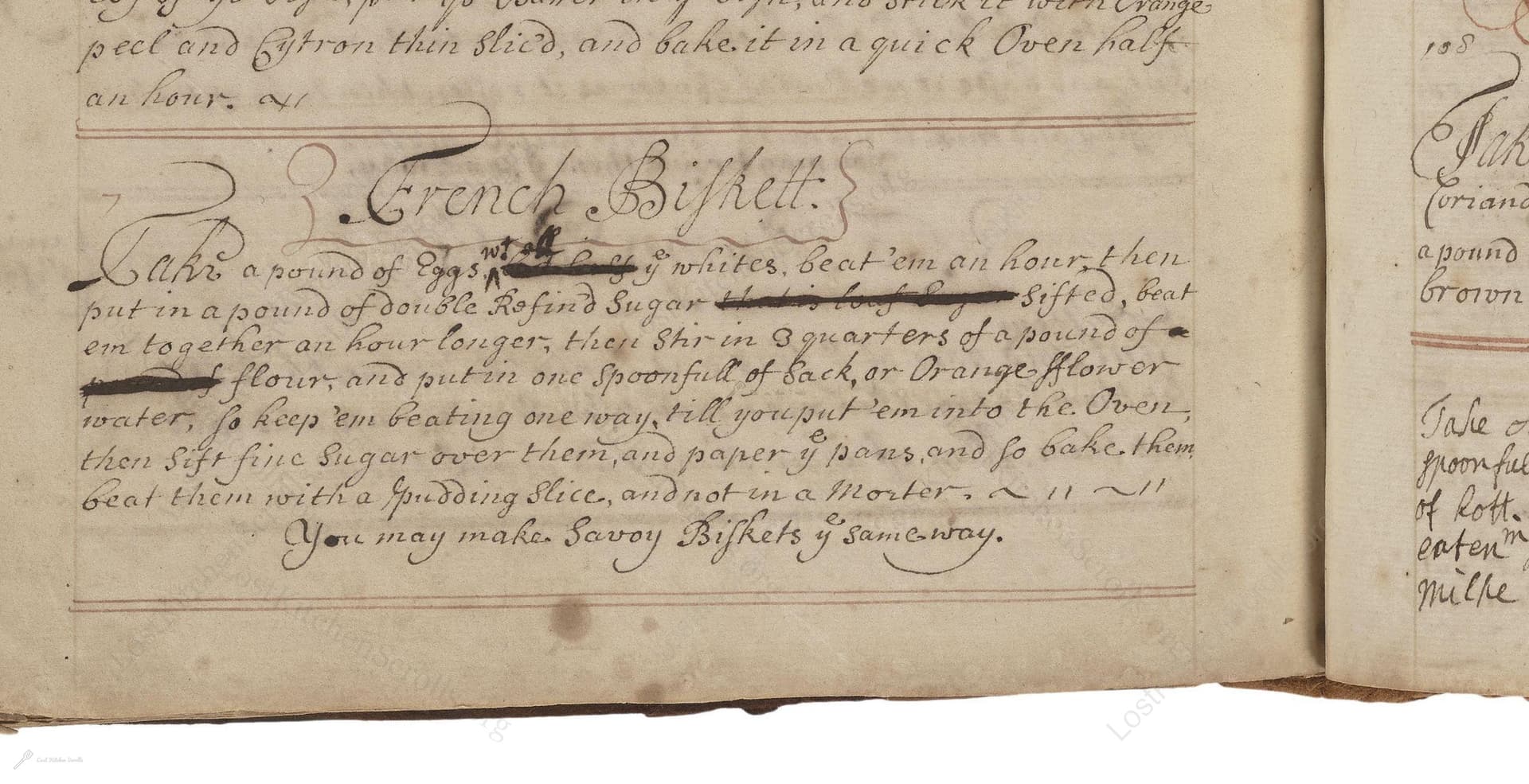A French Biskett
From the treasured pages of English cookery and medicine book,
Unknown Author

A French Biskett
"Take a pound of Eggs, wth all ye whites, beat 'em an hour, then put in a pound of double Refind Sugar thats dry & sifted, beat 'em together an hour longer, then stir in 3 quarters of a pound of flour, and put in one spoonfull of Sack, or Orange flower water, so keep 'em beating one way, till you put 'em into the Oven, then Sift fine Sugar over them, and paper ye pans, and so bake them beat them with a pudding Slice, and not in a Morter. You may make Savoy Biskets ye same way."
Note on the Original Text
Recipes in this period were written as a series of actions, rather than as precise formulae, and assumed a high level of kitchen knowledge. Quantities often referenced whole units (a pound of eggs!) and times were given in hours rather than minutes, reflecting a slower-paced kitchen. Spelling follows the variable conventions of seventeenth-century English (e.g., 'ye' for 'the', 'wth' for 'with', 'Biskett' for 'Biscuit'). Directions like 'beat them one way' mean to keep to a consistent circular motion for maximum aeration. The recipe is notable for emphasizing the use of a pudding slice, not a mortar, to avoid heaviness. It also mentions that this method is suitable for making 'Savoy Biskets'—the classic ladyfinger base for tiramisu today.

Title
English cookery and medicine book, (1694)
You can also click the book image above to peruse the original tome
Writer
Unknown
Era
1694
Publisher
Unknown
Background
A delightful journey through late 17th to early 18th-century kitchens, this tome features recipes, culinary wisdom, and mouthwatering secrets from an era where feasts reigned supreme and the art of cooking was celebrated with flourish.
Kindly made available by
Folger Shakespeare Library
This French Biskett recipe comes from an English manuscript recipe book dating between 1677 and 1711. It reflects the era's fascination with light, airy sponge biscuits originating from continental Europe—often called Savoy Biscuits or Biscuits à la Cuillère. These treats were luxurious, as both sugar and eggs were prized ingredients. The recipe's inclusion of sack (a type of fortified wine similar to sherry) or orange flower water hints at the courtly flavors popular in late Stuart England. Such biscuits would likely be served at special occasions or with possets and dessert wines.

The preparation would have relied on a large earthenware or pewter bowl for beating the eggs—a true arm workout, as the mixture was manually whipped for hours, likely with a flat wooden pudding slice (a sort of spatula). The direction to avoid beating in a 'Morter' (mortar) suggests a desire for airiness, not heaviness. Pans lined with paper helped ensure a clean release, as nonstick bakeware was centuries away. Baking would be in a wood-fired oven, carefully monitored for gentle, even heat. A sieve was necessary for sifting the sugar both into the batter and over the biscuits before baking.
Prep Time
2 hrs 20 mins
Cook Time
15 mins
Servings
30
We've done our best to adapt this historical recipe for modern kitchens, but some details may still need refinement. We warmly welcome feedback from fellow cooks and culinary historians — your insights support the entire community!
Ingredients
- 10 large eggs (about 18 oz, whole, shelled)
- 1 lb (16 oz) caster sugar (superfine, sifted and dry)
- 12 oz plain flour
- 1/2 fl oz sack (substitute: sweet sherry) or orange flower water
- Extra caster sugar, for dusting
Instructions
- To make French Bisketts in a modern kitchen, start by taking about 10 large eggs (weighing close to 18 oz, shells removed, whites and yolks included) and beat them for a full hour until they're ultra-light and pale—a stand mixer makes this much easier!
- Gradually add 1 lb (16 oz) of finely sifted caster sugar and keep beating for another hour, aiming for a very thick, glossy ribbon stage.
- Gently fold in 12 oz of plain flour, being careful not to deflate the mixture.
- Add a generous tablespoon (about 1/2 fl oz) of either sweet sherry (as a stand-in for sack) or orange flower water for a delicate floral note.
- Continue mixing gently, always folding in the same direction.
- Line your baking trays with parchment paper, spoon or pipe the batter into small rounds or fingers.
- Sift a fine veil of sugar on top.
- Bake at 350°F for about 12–15 minutes, or until the biscuits are lightly golden and crisp.
- Let cool before enjoying.
Estimated Calories
90 per serving
Cooking Estimates
It takes about 2 hours to beat the eggs and sugar until fluffy, plus around 20 minutes to fold in flour, flavorings, and prepare the trays. Baking takes about 15 minutes. One batch makes about 30 biscuits, each with roughly 90 calories.
As noted above, we have made our best effort to translate and adapt this historical recipe for modern kitchens, taking into account ingredients nowadays, cooking techniques, measurements, and so on. However, historical recipes often contain assumptions that require interpretation.
We'd love for anyone to help improve these adaptations. Community contributions are highly welcome. If you have suggestions, corrections, or cooking tips based on your experience with this recipe, please share them below.
Join the Discussion
Rate This Recipe
Dietary Preference
Main Ingredients
Culinary Technique

Den Bockfisch In Einer Fleisch Suppen Zu Kochen
This recipe hails from a German manuscript cookbook compiled in 1696, a time whe...

Die Grieß Nudlen Zumachen
This recipe comes from a rather mysterious manuscript cookbook, penned anonymous...

Ein Boudain
This recipe comes from an anonymous German-language manuscript cookbook from 169...

Ein Gesaltzen Citroni
This recipe, dating from 1696, comes from an extensive anonymous German cookbook...
Browse our complete collection of time-honored recipes



